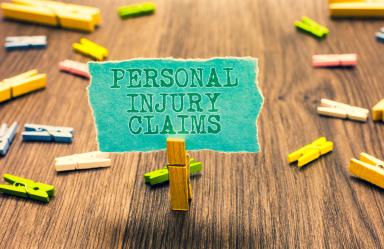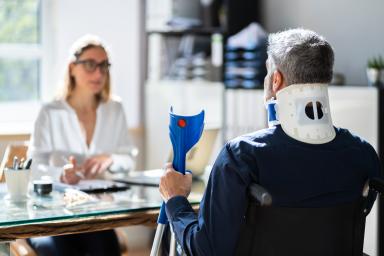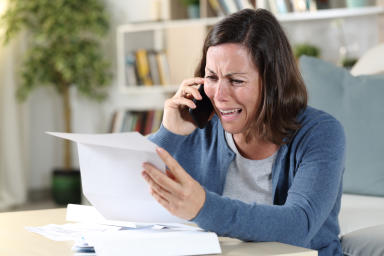Types of Evidence Presented in Personal Injury Lawsuits [2024]

After an accident, you might sustain injuries that prevent you from working, lead to significant medical bills, and make it difficult for you to go about your day-to-day life.
According to United States Courts, personal injury filings increased by 97% in 2020, totaling 45,523 cases. If you find yourself the victim of an accident that results in a personal injury, it’s important to know what steps to take and what types of evidence to collect to support your case so that you can get the compensation you deserve.
Physical evidence, photographs, witness statements, and other types of evidence can support your claims and ensure your award reflects the damages that you sustained after your accident. Here’s what you need to know about the most common types of evidence used during personal injury lawsuits.
Most Common Types of Evidence Presented During a Personal Injury Lawsuit
When preparing personal injury evidence for a lawsuit, there are several important items to consider. This could include medical records documenting an injury or any incident reports that can help identify fault.
Witness statements and photos or videos of the accident are other vital forms of personal injury evidence. Some cases may also rely on expert testimony from professionals like medical doctors or accident reconstruction experts to paint a complete picture of the incident.
Nearly anything that can demonstrate the extent of your injuries, explain who caused the accident, and show how your injuries impact your life can be helpful in a personal injury lawsuit.
Physical evidence
"Physical evidence" refers to any physical item found at the accident scene. An example of this might be broken glass, skid marks on the road, or debris from the accident. Additionally, weapons, tools, clothing, equipment, vehicles, and other tangible items may be included.
This evidence may be analyzed to help determine fault and demonstrate how the accident contributed to the plaintiff’s injuries. For example, damage to your car can show the force with which another driver hit your vehicle.
It’s important to note that physical evidence can be destroyed or lost over time. Therefore, it’s best to keep a record of any physical evidence as soon as possible after the incident. Physical evidence should be collected immediately and unaltered to ensure it remains in its original condition.
Photos and videos of the accident
Photos and videos can help reconstruct the scene of an accident or illustrate the extent of a person’s injuries. Photographs taken at the scene, especially soon after an incident, can be instrumental in personal injury lawsuits.
Photos and videos also help preserve physical evidence, like the location of objects, road markings, road signs, and skid marks, that can’t be physically collected and presented in a courtroom.
Taking photos or videos of any injuries sustained from the accident is also beneficial. These visual records can provide proof of injury severity and demonstrate how the accident contributed to a person’s injuries.
When taking photos or videos, try to take them as soon as possible after the accident to ensure they accurately represent the scene as it was immediately after the accident. Make sure to take pictures from multiple angles so that you can pick the ones that most clearly highlight the circumstances that led to the accident.
Medical records and bills
If you sustain injuries as the result of someone else’s negligence, one of the first things you should do is seek medical treatment. Follow your doctor’s recommendations for treatments, including meeting with specialists if necessary.
Not only will this help you start your road to recovery and prevent injuries from becoming worse, but this will also ensure you have medical records to support your claims. Medical records can prove the severity of your injuries, treatment cost, and recovery timeline. However, if you don’t follow through with treatment, the defendant may use this to claim that you are exaggerating the extent of your injuries.
Proving the severity of your injuries also helps recover damages for lost wages as it demonstrates to the court that your injuries prevent you from working.
Witness statements
Witness testimony can be a crucial piece of evidence in any trial. Any person who saw or heard anything relating to the incident may be asked to testify, even if they aren’t a direct witness to the accident.
This type of evidence can be invaluable in determining fault and liability. It’s important to take witness statements as soon as possible and to follow up with the witnesses regularly. Witnesses should be asked for their contact information in case they are needed to testify in court.
Witness statements may be provided in person during the trial, or they may be presented as written or recorded statements, depending on the availability of the witness.
Incident reports
After an accident, law enforcement and insurance adjusters may create an incident report detailing the circumstances of the accident and who is at fault.
These reports can be valuable in a personal injury lawsuit as they include information regarding the time and date of the accident, conditions surrounding the accident, and damages sustained as a result of the accident.
While police reports are often inadmissible in court, they can benefit settlement negotiations.
Expert testimony
Expert testimony is commonly used in personal injury cases to support the plaintiff’s claims.
Unlike a witness, an expert doesn’t need to have been present at the time of the accident. Instead, they offer insight that validates your claims. In a personal injury lawsuit, this may include a doctor explaining your injuries, how they affect your ability to perform your job, and how they impact your daily life.
This type of testimony can justify compensation for damages related to medical bills, lost wages, and pain and suffering.
Depositions
Depositions are typically conducted during the discovery phase of a personal injury lawsuit. While these don’t take place in the courtroom, they are still under oath and can help build your case.
During depositions, your attorney may ask witnesses about the incident and discover new information that can help you work toward a settlement or win your lawsuit.
Legal Resources for Injured Folks
If you’ve been injured due to someone else’s negligence, taking legal action can help you get the compensation you deserve so that you can recover from your injuries and move on with your life.
These resources help individuals find information about personal injury lawsuits and find experienced attorneys to represent them.
The American Bar Association (ABA)
The American Bar Association (ABA) offers a variety of resources for people who have been injured. The ABA website features legal advice and links to other organizations and attorneys specializing in personal injury law.
Individuals can find helpful answers to questions like “What happens if I file a lawsuit?” and “What will happen if I win my case?”
Visit: americanbar.org
The National Center for State Courts
The National Center for State Courts offers information on state court systems and how they process personal injury cases.
The website has a searchable database to help locate the appropriate court to file your case and provides helpful legal resources such as sample forms, briefs, and more. This makes it easier for individuals pursuing a personal injury lawsuit to understand what steps to take next and what they can expect.
Visit: ncsc.org
The American Association for Justice (AAJ)
The American Association for Justice (AAJ) is the world’s largest trial bar and provides resources for attorneys and individuals seeking legal representation in personal injury cases.
The AAJ website has a comprehensive library of articles and publications about laws, court decisions, and strategies related to personal injury law. They also offer an online lawyer locator so that you can find an experienced attorney to represent you.
Visit: justice.org
Expertise.com StaffAuthor
Step into the world of Expertise.com, your go-to hub for credible insights. We don't take accuracy lightly around here. Our squad of expert reviewers, each a maestro in their field, has given the green light to every single article you'll find. From rigorous fact-checking to meticulous evaluations of service providers, we've got it all covered. So feel free to dive in and explore. The information you'll uncover has been stamped with the seal of approval by our top-notch experts.




